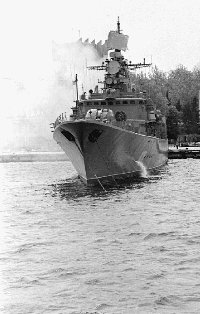Ukraine Tightens Control Over Black Sea Fleet

What caused Moscow's irritation was Ukrainian government resolution No. 863. In addition to itemizing the procedure of crossing Ukraine's border by BSF personnel, it also lays down two fundamental principles. First, all stores intended for the BSF are subject to export control. Secondly, any relocation of BSF personnel and equipment in the Crimea is allowed only after three day notice to the Chief of the General Staff of Ukraine.
The BSF remains, in spite of cuts, an imposing force with 20,000 servicemen, warships, over 100 armored vehicles, aircraft, and artillery. All last year, the BSF prepared under a combat readiness plan for a local war in the region and interdiction of Black Sea transit passages, as well as holding nuclear-theater exercises. In case of real hostilities Ukraine could be drawn into the conflict, for the BSF would strike from Ukrainian territory.
The week before last, after a regular meeting of the joint BSF subcommission,
cochairman for Russia Admiral Konstantin Kolotygin said sulkily that agreement
had not been reached with Kyiv concerning simplified customs control and
replacement of the fleet's warplanes. Moscow wants to equip the BSF with
nuclear-capable Su-24 aircraft. According to the admiral, Ukraine and Russia
are doomed to be together, and "for the sake of this the word no
should be forgotten." In such a case, Ukraine would also have to forget
about such minor details as its neutrality, nonalignment, and nuclear-free
status.
Выпуск газеты №:
№22, (1999)Section
Day After Day





